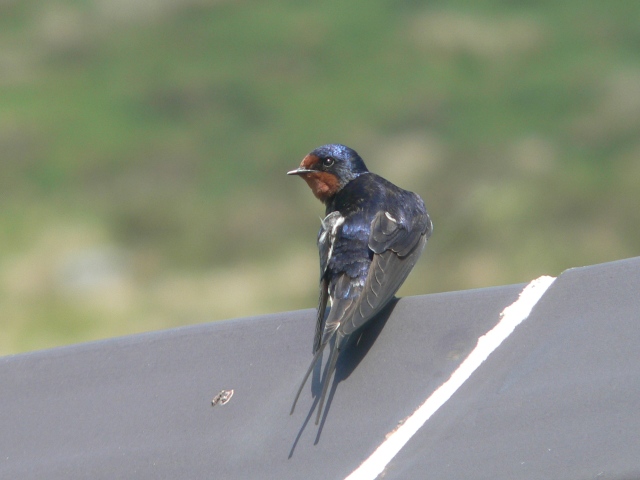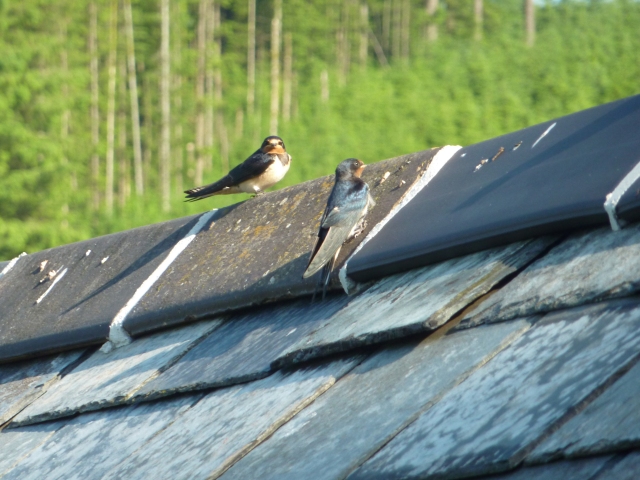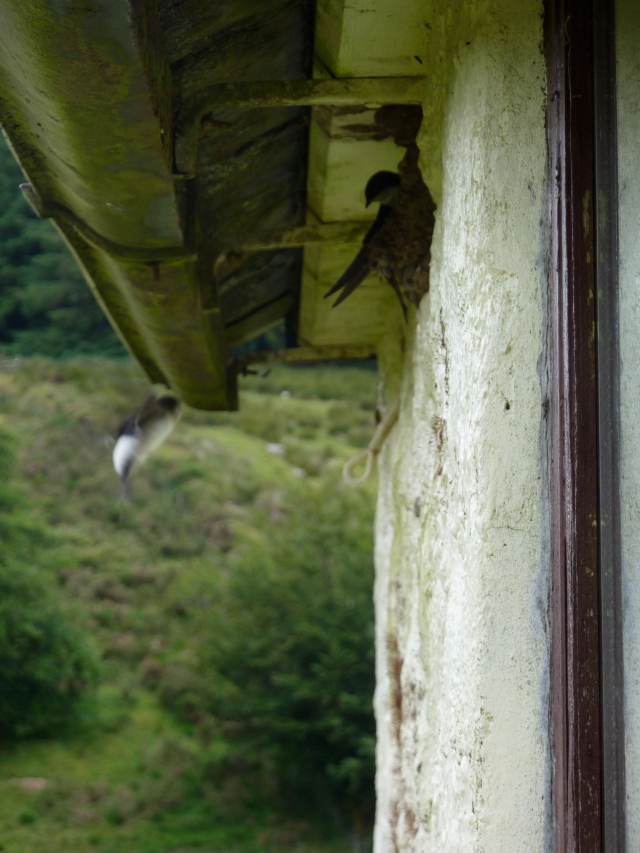Mission bells ring as crowds gather, with all eyes turned toward the skies. Mariachis play, a parade marches past and a huge fiesta kicks off to celebrate the annual return of the legendary Cliff Swallows at Mission Capistrano in California. While Roger and I may not greet the ancestral migration of the equally loyal and remarkable Swallows of Crockern with a fete, we find their annual return and summer visit remarkable nonetheless. (See also, https://crockernfarm.wordpress.com/2013/04/30/bird-song-dartmoor-cuckoos/).
Consider the distance they’ve traveled from Africa, managing to negotiate their way back to their birthplace, here at Crockern, just to raise their young at our house. Admittedly, I could use some of their navigational skills as more than a few times I’ve found myself lost down a Dartmoor country lane. Once here, the Swallows roost under the eaves of the house; inside the barn, chicken coop, and all the sheds; on top of some fencing we left propped up in a corner; and, among debris I was planning to take to the tip, but now must delay.
There is an old saying, “When the Swallows fly high, the weather will be dry.” I remain skeptical as to whether or not one can accurately predict the weather by observing the flight pattern of a Swallow, but their busy nature does confirm a fine day in the making. The warmer and dryer the weather, the more bugs and with them, more Swallows on the hunt. We have had an extended run of clear days this summer and so have been outside addressing a number of projects. In the past two weeks we have completed our track repairs, built a concrete base for a new oil tank, mended more of the stonewalls, and kept abreast with the growth in the vegetable garden. Being outside for most of the day I am drawn to watching the zigzagging flight patterns of our Swallows. I know we don’t own these Swallows, but I think of them as part of the gang of critters and creatures who consider Crockern their home and as such, they are part of our family.
Like any family member, they give great joy along with the occasional annoyance. Take for instance their wonderful chirping calls as they dive bomb through the air feeding along the way. Swallows have a number of songs to communicate excitement, attract a mate, or issue an alarm. Typically, their delightful musical twitterings are comprised of a simple melody followed by clicking sounds. But the call denoting “Feed Me!” by the young, that early morning demand and begging solicitation, is most uncivilized and wakes me up. This is neither cute nor clever.
Despite this rude awakening, I find Swallows to be among the loveliest of birds with their graceful movements and bodies shining blue and black when the sun hits their glossy wings. I like seeing their pale bellies, splashes of red at their throat, and those long tail feathers as they soar through the air. Sometimes when the Swallows return up the valley, I watch their flying dance imaging if each were trailing long bits of fibre, how they could easily braid a rope. Mostly, I find their flight agility as nothing short of miraculous. It’s a noisy, busy, aerial display available daily confirming the most basic truth: the smallest things make life wonderful.
There are few predators agile enough to catch a Swallow, but sometimes Sparrowhawks or Hobbies are able to do so in flight. I love Sparrowhawks and cheer on their survival, but I do not want to be witness to the snatching of a Swallow. Which side to choose? While shoveling the umpteenth bucket of rocks (by the end of a single day, nearly two tones shoveled and moved) to make the concrete mixture, I looked up and saw a scene reminiscent of Hitchcock’s The Birds, with about thirty Swallows mobbing a Sparrowhawk near the trees by the river. From the distance, I don’t know if the Sparrowhawk held a Swallow in its clutches, but I do know that the Flight of Swallows saw off this spectacular bird of prey.
I enjoy the aerial acrobatics of these elegant birds and happily benefit from their insect hawking expertise. Mosquitoes, Midges and Aphids are among the Swallows’ food, captured and devoured almost constantly while in flight. The Swallows may be helping our broad beans survival since our beans have a few aphids, despite the companion planting of nastursum (admittedly, planted too late) and leaving a patch of nettles nearby. I recently learned that a Swallow consumes 60 insects per hour, based on a 14-hour day, that’s a whopping 840 per day! At last count, we have twenty-three nests, with at least 2-6 Swallows per nest, so by my calculations, that is over 77,000 fewer insects, on average, when we are enjoying our bar-b-que. How can you not love Swallows?
And so what if they are a bit piggish, aren’t they entitled? These birds give new meaning to Puritan Work Ethic: constantly catching food, repairing nests, singing songs, and coursing back and forth over 600 miles a day, at an average speed of 45 miles per hour, as they forage for bugs. They spend most of their waking hours on the wing, more than any other songbirds in the world, and do this just to catch enough flying insects for their survival and that of their young. When they aren’t swooping about, they rest briefly on tree branches or on our roof, the very one we had repaired in December.
When the Swallows returned in April, following our roof repair, they had some construction work of their own as some of their nests were damaged where we replaced guttering. It took the parents about a week to build and restore their nests; working dawn to dusk with only brief rests. Just outside our bedroom window is a cup nest tucked up under the rafters. If I sit quietly, I can watch the Swallows zoom towards it, hover briefly and then shoot off in a new direction. I can only view this nest from an odd angle as I hang out the window, so I am left to guessing the number of young living in it. What I can see are thousands of small mud pellets used in its construction. As Roger and I move onto the next round of projects, we may wish to observe how Swallows accomplish so much in the course of a day. Whatever their secret, I draw the line at living off of bugs.
There is something comforting in the knowledge that each summer we can expect the Swallows’ return to Crockern. And while they are here and I enjoy their beauty, their intrigue, and their bug-eating enthusiasm, I must also make a note — before they flock and begin their epic migratory journey away, crossing Europe, the Mediterranean, deserts and the equator — to locate some bells to ring in their return next year.
“When the Swallows come back to Capistrano
That’s the day you promised to come back to me.
When you whispered ‘Farewell’ in Capistrano
‘twas the day the Swallows flew out to sea.”



lovely text and photos! The Saturday Guardian had a piece about birds including swallows – but swifts are my all-time favourite bird. Do you have those?
Thank you Annette. I love swifts, too, but living under the eaves of the house are swallows and a few house martins. We do have a pied wagtail living in the stone wall of a shed, which was a fun recent discovery.
I really enjoy your writing and the detailed way you see the wonderful nature who surround you at Crockern Farm. A far cry from the world of Cheese Please. Love to you both. F x
Thanks Fiona and I just have to say, no matter where I am I will always have a bit of Cheese Please (best cheese shop in Lewes — shameless plug!!!!). x
beautiful birds – and lovely music. A travel down memory lane
I couldn’t agree more — hope memory lane keeps providing fond memories, too.
Very enjoyable post. The swallows seem to be extra-good this year – maybe a late start. [Music? I can’t read / hear the words ‘Mission Bell’ without getting Hotel Ruddy California in my head]. Staying at Tor Royal late Aug – a chance to explore your neck of the woods…
Our neck of the woods includes Wistman’s Woods, so I do hope the weather is on your side when you are out exploring this part of Dartmoor! Thanks for enjoying the post.
Nancy and I are awaiting the completion of her father’s triple bypass surgery. Your post was lovely reading during this unbearably stressful day , and we especially loved when you said,”I watch their flying dance imaging if each were trailing long bits of fibre, how they could easily braid a rope”. We both say you are an excellent writer, getting better & better. XO.
Mike, I hope everything goes well for Nancy’s father. When my Mom had a triple bypass about a dozen years ago it was beyond stressful. I was also amazed at how over the course of 24 hours she rapidly improved. Three days later, it was again remarkable in the giant leaps of improvement. All the best for all of you. And I’m happy to know that this blog helped to bring some peace in the midst of a day where it can feel that there may be none. C xx
It went well, thankfully! What a day. Seriously, your writing provided not only distraction, but beauty and solace, at the height of the stress. Thanks!
I’m relieved and happy to hear that the surgery went well. Onto a speedy recovery, now! Thanks for letting me know.
I love your writing style. If they could speak, I wonder what tales they would tell of their epic journeys!
Thank you Rob. I couldn’t agree more, what adventures these birds must have doing all of that travel.
[…] A Flight of Swallows (crockernfarm.wordpress.com) […]
[…] A Flight of Swallows […]
Just noticed this July post; enjoyed it thoroughly, so thanks for the reminder that summer will eventually occur in 2014. We’re fans of swallows, too, and have the pleasure of a few nests of Barn Swallows on the underside of our yacht club’s dock. It’s so cool to be walking down the dock in the morning with the railing lined with them, including their young, only flying off when you’re just a few feet away. They like the mud at the mouth a little wetland zone across from the club. My only worry is that the dock’s being rebuilt this winter, and they’ll have to start from scratch – hopefully they’ll tear a page out of your swallows’ book! I’m assuming you have just the right the combination of eaves and desirable mud there on the River Dart. I’ve heard (probably apocryphal) stories of the number of insects they eat . . . but they definitely keep the mosquitoes down in their area. One of most amazing bird-watching experiences we’ve had was seeing a “kettle” of Tree Swallows in the dunes of upper Cape Cod: hundreds of them in a tornado-like swirling shape that went so high in the sky you could no longer make them out. Okay – enough! But we want to thank you for “liking” our little Hurricane Sandy table. (I keep wanting to re-shoot it – it should’ve had a couple of glasses of wine sitting on it!) We’ve got plans for another wacky-looking little table with a slab of the same sort of sandstone . . . one of these days!
Couldn’t agree more about how fantastic it is to watch Swallows. I do love them, and they do let us know the weather has changed. Your table is terrific and would look all the more inviting for the glass of wine. I can see it now! Looking forward to your next creation.
[…] A Flight of Swallows […]
[…] A Flight of Swallows […]
[…] Almost all will likely leave before they breed. This spring, we hope for a big return in our Swallows and House Martins, numbers having been inexplicably down the past few […]
[…] spring, we have swallows and house martins. Our pond will serve as a great place for them to use muddy areas to aid in their nest […]
[…] Swallows make the spring. Their aerial gymnastic arrival, eating insects on the wing and diving in and out of our outbuildings, is right up there with the start of baseball season or BBQs with friends. They build their mud nests, have 2-3 broods, eat loads of bugs and sing their happy chatter song throughout the long summer days. By September, they show their restlessness, fluttering about on the barn roof, and prepare to migrate back to Africa. Their return journey takes about six weeks. Swallows from different parts of Europe fly to different destinations, but according to the RSPB, our visitors to England end up in the very southern parts of Africa, traveling down through western France and eastern Spain into Morocco, crossing the Sahara Desert and the Congo rainforest, before finally reaching as far south as South Africa and Namibia. […]
[…] hoping for some extended family members to arrive in the days to come. Soon joining these summer migrants will be the Cuckoo whose call will be heard across the […]